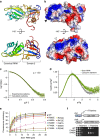The conserved protein Seb1 drives transcription termination by binding RNA polymerase II and nascent RNA
- PMID: 28367989
- PMCID: PMC5382271
- DOI: 10.1038/ncomms14861
The conserved protein Seb1 drives transcription termination by binding RNA polymerase II and nascent RNA
Abstract
Termination of RNA polymerase II (Pol II) transcription is an important step in the transcription cycle, which involves the dislodgement of polymerase from DNA, leading to release of a functional transcript. Recent studies have identified the key players required for this process and showed that a common feature of these proteins is a conserved domain that interacts with the phosphorylated C-terminus of Pol II (CTD-interacting domain, CID). However, the mechanism by which transcription termination is achieved is not understood. Using genome-wide methods, here we show that the fission yeast CID-protein Seb1 is essential for termination of protein-coding and non-coding genes through interaction with S2-phosphorylated Pol II and nascent RNA. Furthermore, we present the crystal structures of the Seb1 CTD- and RNA-binding modules. Unexpectedly, the latter reveals an intertwined two-domain arrangement of a canonical RRM and second domain. These results provide important insights into the mechanism underlying eukaryotic transcription termination.
Conflict of interest statement
The authors declare no competing financial interests.
Figures



 , 1.104), the peak position of an ideal globular and rigid protein. Rigid proteins show a characteristic parabolic shape with a peak at the indicated position (as is the case here), while unfolded proteins would plateau with increasing q-values. (e) Analysis of Seb1-SUMO-RRM388–540 binding to FAM-tagged AUUAGUAAAA RNA by FA. Error bars indicate standard deviation of three technical replicates. (f) Spot test showing the effect of the indicated Seb1-RRM point mutations on cell growth.
, 1.104), the peak position of an ideal globular and rigid protein. Rigid proteins show a characteristic parabolic shape with a peak at the indicated position (as is the case here), while unfolded proteins would plateau with increasing q-values. (e) Analysis of Seb1-SUMO-RRM388–540 binding to FAM-tagged AUUAGUAAAA RNA by FA. Error bars indicate standard deviation of three technical replicates. (f) Spot test showing the effect of the indicated Seb1-RRM point mutations on cell growth.


Similar articles
-
Elongation/Termination Factor Exchange Mediated by PP1 Phosphatase Orchestrates Transcription Termination.Cell Rep. 2018 Oct 2;25(1):259-269.e5. doi: 10.1016/j.celrep.2018.09.007. Cell Rep. 2018. PMID: 30282034 Free PMC article.
-
Termination of non-coding transcription in yeast relies on both an RNA Pol II CTD interaction domain and a CTD-mimicking region in Sen1.EMBO J. 2020 Apr 1;39(7):e101548. doi: 10.15252/embj.2019101548. Epub 2020 Feb 28. EMBO J. 2020. PMID: 32107786 Free PMC article.
-
The RNA polymerase II C-terminal domain-interacting domain of yeast Nrd1 contributes to the choice of termination pathway and couples to RNA processing by the nuclear exosome.J Biol Chem. 2013 Dec 20;288(51):36676-90. doi: 10.1074/jbc.M113.508267. Epub 2013 Nov 6. J Biol Chem. 2013. PMID: 24196955 Free PMC article.
-
Polyadenylation site selection: linking transcription and RNA processing via a conserved carboxy-terminal domain (CTD)-interacting protein.Curr Genet. 2017 May;63(2):195-199. doi: 10.1007/s00294-016-0645-8. Epub 2016 Aug 31. Curr Genet. 2017. PMID: 27582274 Review.
-
Gene-specific requirement of RNA polymerase II CTD phosphorylation.Mol Microbiol. 2012 Jun;84(6):995-1004. doi: 10.1111/j.1365-2958.2012.08071.x. Epub 2012 May 4. Mol Microbiol. 2012. PMID: 22553990 Review.
Cited by
-
Histone deacetylation promotes transcriptional silencing at facultative heterochromatin.Nucleic Acids Res. 2018 Jun 20;46(11):5426-5440. doi: 10.1093/nar/gky232. Nucleic Acids Res. 2018. PMID: 29618061 Free PMC article.
-
Genetic screen for suppression of transcriptional interference identifies a gain-of-function mutation in Pol2 termination factor Seb1.Proc Natl Acad Sci U S A. 2021 Aug 17;118(33):e2108105118. doi: 10.1073/pnas.2108105118. Proc Natl Acad Sci U S A. 2021. PMID: 34389684 Free PMC article.
-
Ten principles of heterochromatin formation and function.Nat Rev Mol Cell Biol. 2018 Apr;19(4):229-244. doi: 10.1038/nrm.2017.119. Epub 2017 Dec 13. Nat Rev Mol Cell Biol. 2018. PMID: 29235574 Free PMC article. Review.
-
Advantages and limitations of UV cross-linking analysis of protein-RNA interactomes in microbes.Mol Microbiol. 2023 Oct;120(4):477-489. doi: 10.1111/mmi.15073. Epub 2023 May 10. Mol Microbiol. 2023. PMID: 37165708 Free PMC article. Review.
-
Polyadenylated versions of small non-coding RNAs in Saccharomyces cerevisiae are degraded by Rrp6p/Rrp47p independent of the core nuclear exosome.Microb Cell. 2024 May 22;11:155-186. doi: 10.15698/mic2024.05.823. eCollection 2024. Microb Cell. 2024. PMID: 38783922 Free PMC article.
References
-
- Martens J. A., Laprade L. & Winston F. Intergenic transcription is required to repress the Saccharomyces cerevisiae SER3 gene. Nature 429, 571–574 (2004). - PubMed
-
- Kim M. et al.. The yeast Rat1 exonuclease promotes transcription termination by RNA polymerase II. Nature 432, 517–522 (2004). - PubMed
-
- Kobor M. S. & Greenblatt J. Regulation of transcription elongation by phosphorylation. Biochim. Biophys. Acta 1577, 261–275 (2002). - PubMed
-
- Buratowski S. The CTD code. Nat. Struct. Biol. 10, 679–680 (2003). - PubMed
Publication types
MeSH terms
Substances
Grants and funding
LinkOut - more resources
Full Text Sources
Other Literature Sources
Molecular Biology Databases

